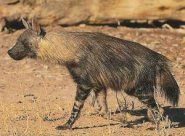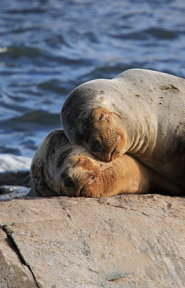Wednesday 16 April 2008
Brown hyena

The
Brown Hyena (
Parahyaena brunnea) inhabits the Kalahari and Namib deserts in the south of Africa in Zimbabwe, Namibia, Angola and Botswana. The male on average weighs about 39 kilograms, with a big head, large teeth and sharp ears, and its coat is made up of long hair, colored with a deep shade of brown bearing black spots.
It resembles a
Striped hyena, but they would never meet, as the Striped hyena lives in the north of African and the Brown hyena in the south. It is smaller than the
Spotted hyena, and is mainly a scavenger, hunting for meat as its primary food, but it would not let go of vegetables and fruits if they are available. Other parts of their diet include insects and seal pups on the coastline of Namibia. Melons for the Brown Hyena are important sources of moisture for the dry months, eight months in theory.
They live in clans (4-15 members) and have their own hierarchy. The rank order determines its submission and dominance. Every Brown hyena exhibits scent-posting, and an individual Brown Hyena would defend its home against other males from a rival clan. The fascinating part is this: one would show very little aggressiveness to a nomadic individual. How they are able to differentiate between a nomadic one from a non-nomadic Brown Hyena is unknown.
Those who meet at a carcass probably tolerate each other. Still, up to 3 individuals only feed on that carcass and, if a fourth one comes up, he would have to wait. Spotted hyenas as well as African wild dogs are known to chase off the Brown hyenas from a kill.
Lions and
humans are predators of the Brown hyena.
Interesting fact: Those species scavenging along the Atlantic shoreline have been given the name 'strandloper', which can be translated as 'beach walker'.
Picture of the Brown hyena by
http://www.pistoleros.no, licensed under
GFDL.
You can help spreading the word about this animal by liking it on facebook
Permanent Link
Thursday 03 April 2008
South American sea lion

The
South American Sea Lion (
Otaria byronia), also known as the Southern sea lion, varies in size from one individual to another. Males can reach up to 300 kilograms while the females are half of that. The adult holds a dark brown back and the chest is lighter-shaded. A male South American Sea Lion's mane is lighter in color than the female's.
They could be sighted at the offshore islands of South America, North Peru and even parts of Ecuador. Their estimated numbers are as follows: 30,000 at Peru, 90,000 at Argentina and 3,000 at Falkland islands. At Brazil, just a few hundreds exist.
The female South American Sea Lions reach sexual maturation at four to six years, while the males reach it in five to six years. Pups are born just 3 days after the female's arrival in the nesting grounds (called rookeries). The male newborns average weight is 13.7kgs, while the females are 12.3kgs at average. Females (the parent) would usually mate about a week after birth, then, the feeding cycle would commence. The pups start swimming after a month, and when they reach 2 months old, they are already capable swimmers.
In the 19th and 20th centuries, they were hunted excessively, and it depleted a great part of their numbers. Furthermore, he salmon fishing line of Chile has caused these sea lions to get entangled in the nets. In the mid 90's, the Chilean government banned the "destruction" of the South American Sea Lion for five straight years.
There is another reason for the decline of their numbers, and this one is not to be blamed on mankind: the El Nino. At Peru and Chile, it had been reported that the El Nino of 97-98 greatly cut down the overall numbers of these animals.
Interesting fact: The less "courageous" males unable to set up territories have been observed to assault undefended females, and the pups too. In some cases, they would try to mate with it, killing it inadvertently.
Picture of the Mother South American sea lion and pup by
Carlos Ponte, licensed under
GFDL
You can help spreading the word about this animal by liking it on facebook
Permanent Link
 The Brown Hyena (Parahyaena brunnea) inhabits the Kalahari and Namib deserts in the south of Africa in Zimbabwe, Namibia, Angola and Botswana. The male on average weighs about 39 kilograms, with a big head, large teeth and sharp ears, and its coat is made up of long hair, colored with a deep shade of brown bearing black spots.
The Brown Hyena (Parahyaena brunnea) inhabits the Kalahari and Namib deserts in the south of Africa in Zimbabwe, Namibia, Angola and Botswana. The male on average weighs about 39 kilograms, with a big head, large teeth and sharp ears, and its coat is made up of long hair, colored with a deep shade of brown bearing black spots. 
 The
The